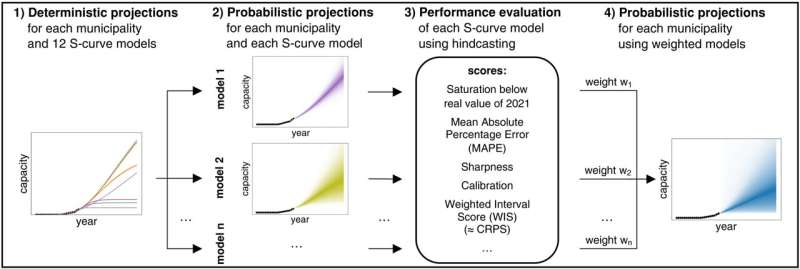This article has been reviewed according to Science X's editorial process and policies. Editors have highlighted the following attributes while ensuring the content's credibility:
fact-checked
peer-reviewed publication
trusted source
proofread
Energy transition: A super-model to guide policy makers

How can we ensure that an energy policy will achieve its objectives? To find out, scientists and public authorities can rely on computer models of varying degrees of accuracy. However, these models have a number of limitations, including the fact that they are not very effective for generating projections on a regional scale.
A team from the University of Geneva (UNIGE) has designed a super-model to simulate the spread of three green technologies in Swiss municipalities by 2050. It is based on available statistics and combines 12 existing models of technology growth, while testing their relevance. The results, published in the journal PNAS Nexus, could help inform political decision-making.
Computer modeling is a key tool in the energy transition. By creating models of reality, it enables scientists and public authorities to measure, in the more or less long term, the effects of strategies aimed at mitigating climate change. It is used, for instance, to simulate scenarios for transforming energy production, storage and consumption infrastructures in a given area.
Reliable projection tools have become increasingly necessary as many countries, including Switzerland, aim for carbon neutrality by 2050. However, the models available to guide political decisions have their limitations. They take little or no account of uncertainty and therefore lead to overconfidence. Their spatial resolution is too low to support decision-making at local level. Last, for the same area, their projections can differ significantly.
Projecting on a local scale
To address this problem, a UNIGE team has developed a new "probabilistic" model, sponsored by the Swiss Federal Office of Energy's SWEET program and performed by the SURE consortium. Rather than pointing to a particular outcome as the definitive forecast—the hallmark of deterministic models—it generates projections containing a set of probabilities associated with a wide range of possible future outcomes. It can also be used to determine which existing model is the most relevant for a municipality or region.
"This model has been designed to generate projections for the municipal-scale distribution of three specific energy technologies: photovoltaics, heat pumps and battery electric vehicles. It is fed by the data available for each municipality and combines 12 existing models, while at the same time testing them," explains Nik Zielonka, a Ph.D. student in the Renewable Energy Systems Group at the UNIGE's Institute of Environmental Sciences (ISE), and first author of the study.
Tested in all Swiss municipalities
To test their model, the researchers chose Switzerland (2,148 municipalities) because local data on the spread of energy technologies are accurate and accessible. Using data for the period 2000–2021, the team generated projections of the level of development of these technologies up to 2050 using a supercomputer. These results enable each municipality to measure the gap between this projected reality and their objectives.
Scientists carried out the exercise with Thun (43,000 inhabitants) where the energy objectives are clearly quantified. To achieve carbon neutrality, the city is counting on a photovoltaic energy capacity of more than 120 MW by 2050 (currently less than 20 MW) and on putting about 12,000 electric vehicles on the road (currently less than 500). However, according to the UNIGE model, if Thun continues on its current path, it is likely to achieve just 90 MW and fewer than 8,000 electric vehicles by 2050.
The 2050 horizon is unrealistic
"If we look at our results as a whole, it seems highly unlikely that Switzerland will achieve zero net carbon emissions by 2050, without further changes in policy, at least when it comes to the needed levels of solar photovoltaic, heat pumps, and electric vehicles. Switzerland will have to step up its efforts and the recent 'Mantelerlass' is the first step in the right direction," says Evelina Trutnevyte, head of the Renewable Energy Systems Group at the Institute of Environmental Sciences (ISE) and associate professor in the Section of Earth and Environmental Sciences at the UNIGE's Faculty of Science, who led this research.
The projections obtained as part of this study are freely available and are also updated with most recent data. The next step for the research team will be to extend this model to other European countries. It will also involve including more energy technologies in the model, while combining more existing models.
More information: Nik Zielonka et al, Probabilistic projections of granular energy technology diffusion at subnational level, PNAS Nexus (2023). DOI: 10.1093/pnasnexus/pgad321















